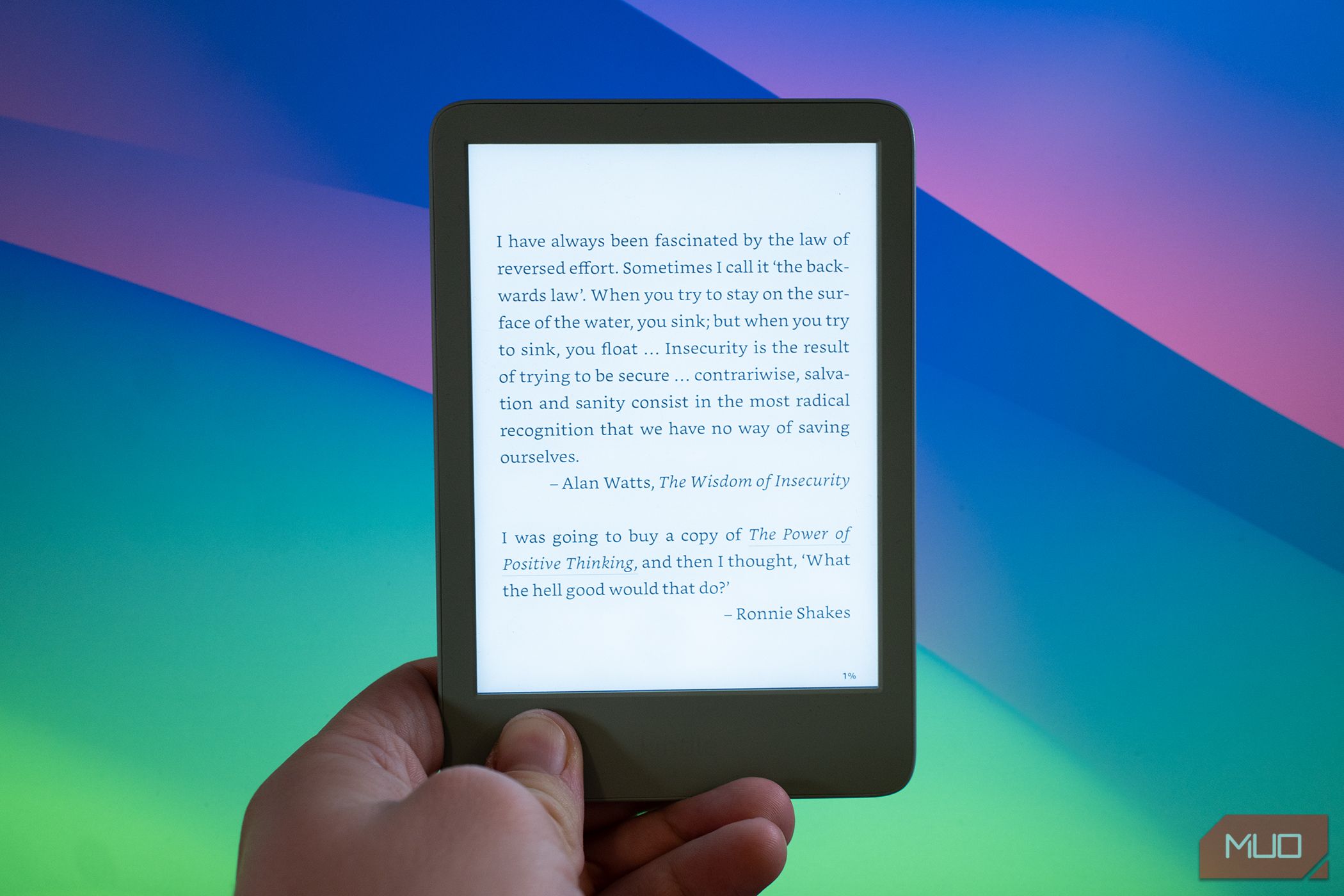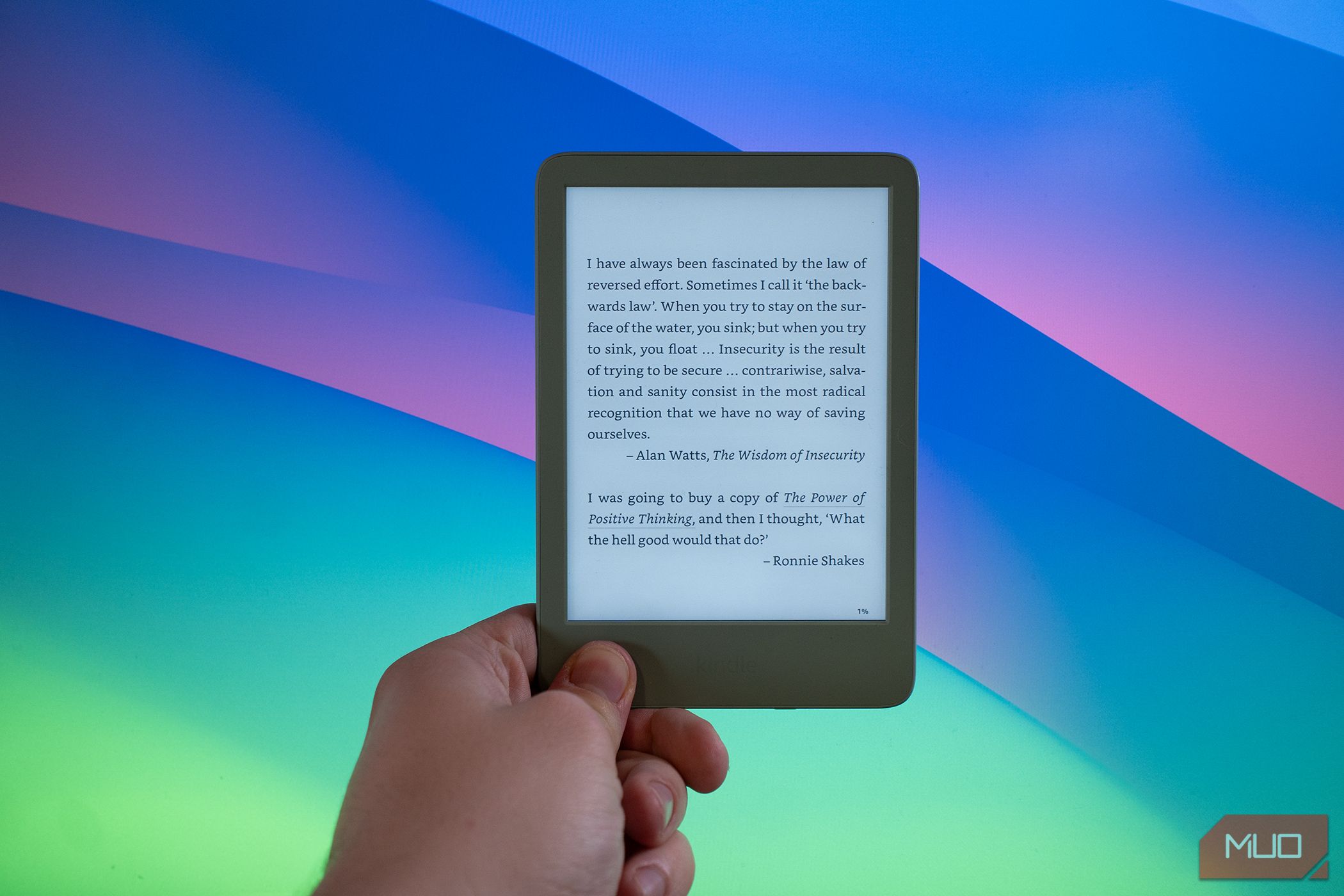The 2024 Amazon Kindle offers a minor refresh upon the 2022 11th-generation model. It’s 25% brighter than the previous model but otherwise mostly unchanged other than a new matcha green color. While this Kindle is indeed the newest basic model, all Kindles are made for one thing: reading books.

Amazon Kindle (2024)
The 2024 Amazon Kindle offers a basic refresh on the 2022 11th generation model, with 25% higher brightness and new matcha green. It offers 16 GB of memory, USB-C connectivity, and access to Amazon’s wide Kindle and Kindle Unlimited library.
- Good value for price
- Compact size and light weight good for portability
- Higher brightness enhances utility
- Access to Kindle library and features
- Superb battery life for casual use
- Battery life is misleading in marketing
- Almost nothing meaningfully changes since the 2022 model
- Laggy display with frequent ghosting
Price and Availability
The Amazon Kindle (2024) costs $89.99 if ad-supported or $109.99 if ad-free. It is available at Amazon, Best Buy, and Target. The available colors are Black and Matcha green.
The New Kindle Offers a Brighter Display and New Color Options
The newest basic Amazon Kindles alleges that its screen is 25% lighter than its 2022 counterpart. Upon setting this device at full brightness, this is clear when placing it against a 4K ASUS ProArt monitor at 85% brightness, as seen above.
Its lowest brightness level is below, which is quite dim yet still legible. Note that the camera utilized manual exposure settings to fully display the changes.
Last, my preferred brightness level of 18 is below to show its default settings and my preferences.
At 94 nits, this basic Amazon Kindle now has brightness parity with more premium Kindle models such as the Paperwhite and Paperwhite Signature. I doubt many users will use this higher maximum brightness level—I personally enjoy the default brightness level of 18 most, as it is bright enough to read outdoors while dim enough to read in bed. However, I appreciate Amazon setting brightness parity across devices.
The other difference from the 2022 Kindle is the color selection. Matcha green is a welcome replacement for 2022’s denim blue. It’s bright yet subdued, making it a fun color with more personality than other options without being excessively so. If I had the option, I’d pick colors like this on many more devices.
Not Much Has Changed Since 2022
As for weight, size, and storage, this Kindle is actually the exact same as its 2022 counterpart, with color and brightness being the only clear differences. In fact, the 2022 Kindle is called the “Kindle (11th Generation) – 2022 Release,” while this one is the “Kindle (11th Generation) – 2024 release,” which indicates how minor of a product refresh this is—not to mention the product pages using the exact same graphics in some areas.
That said, the 2022 Kindle—and thus the new 2024 model, too—have some great things going for them. 16 GB of storage allows for thousands of books, while the compact size and good battery life make it easy to pack in a pocket for day use or a bag for a longer trip. It also offers USB-C, which is better than Kindle models as recent as 2020 that use microUSB, though its unlock button is on the bottom next to the port—an awkward spot.
Battery Life Is Good but Somewhat Misleading
Amazon states that this Kindle boasts six weeks of battery life. However, reading between the lines, this is based on six weeks of reading 30 minutes a day at a brightness level of 13. Functionally, this means you can expect 21 hours of usage on this device per full charge at 13 brightness, only reading books. Most people will use higher brightness levels, and others might connect Bluetooth headphones to listen to Audible audiobooks, reducing its effective battery life.
A battery of up to 21 hours certainly isn’t awful, but I expect many will be disappointed if the six-week claim is false. As flashy as a six-week battery claim is, I’d appreciate it if more spec-based or standardized metrics were used, such as, “With standard use, expect 21 hours of battery, meaning up to six weeks of reading on one charge.” I understand the marketing need to focus on benefits over specs, but this vague presentation of specs leaves me more confused and annoyed than wowed.
Strengths and Flaws Most Kindles Share
As this is the 2024 basic model of Kindle, don’t expect any flashy new features or major specification upgrades other than the Matcha color that miraculously matches my headphones. Yes, this Kindle has superb battery life, surprisingly good brightness, and a light, compact frame, but if you’ve used a Kindle before, this will likely not wow you.
Kindles make sacrifices to enable their impressive battery lives, and these sacrifices remain highly evident, such as laggy navigation through menus and noticeable ghosting when changing menus or book pages. This does not impact usability when reading, but it especially stood out while setting up the device and navigating many Amazon ad-ridden menus.
This new basic Kindle, while an upgrade to previous basic models, lacks features present in more advanced models like the Paperwhite, which boast extended battery life, faster processing, and a larger screen, among other features. I have previously used a basic Kindle, but I primarily use the apparently discontinued Kindle Oasis line for its navigation buttons and improved water resistance. Nevertheless, if you don’t need more premium features like a larger screen, this Kindle can still perfectly suffice for reading.
The Discount for Allowing Ads Probably Isn’t Worth It
Readers can substantially discount their Kindle by allowing ads on the lock screen to the tune of $20, which is framed as the default price for the device unless you pay a $20 premium to remove ads. As an avid reader who already has enough things vying for my attention, I find these ads incredibly annoying. While relatively unintrusive—only taking a second and an extra swipe to bypass—the last thing I want to see when I intend to read is ads.
I have always opted for the higher price to remove ads on all Kindles I have owned, other than this one. I read every day and don’t want to see ads every day.
Furthermore, if Amazon would prefer readers to buy the ad-enabled version, the company likely makes more money from you having ads than you spend removing them. That said, my problem is with Amazon’s business model for ad enablement rather than the device itself.
Should You Buy the 2024 Amazon Kindle?
The 2024 Kindle offers a modest upgrade from its basic counterpart from 2022, with 25% better brightness. However, very little has changed from generation to generation, so most recent Kindle buyers can likely skip this model.
This Kindle has nothing wrong with it that would be unexpected from a Kindle. I’d recommend it to most people interested in purchasing their first Kindle or making a long-overdue upgrade from an old model. Whether you pay to remove ads is up to your preferences.
Last, if laggy navigation annoys you or if you prefer a slightly larger screen, you might consider more premium Kindle models, such as the Paperwhite or Paperwhite Signature, which have a larger screen and a faster processor, among other features.
Nevertheless, a Kindle is a Kindle—they all read books. The 2024 basic model is good, and I definitely recommend it for a minimal-frills reading experience at a reasonable price.


Amazon Kindle (2024)
The 2024 Amazon Kindle offers a basic refresh on the 2022 11th generation model, with 25% higher brightness and new matcha green. It offers 16 GB of memory, USB-C connectivity, and access to Amazon’s wide Kindle and Kindle Unlimited library.



















